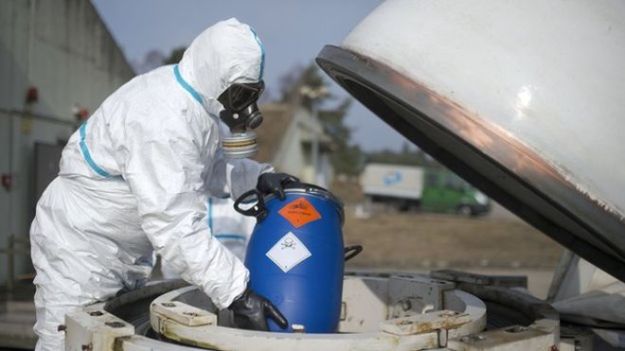By Kyle Orton (@KyleWOrton) on 13 June 2017

(source)
The U.S. Treasury Department’s Office of Foreign Assets Control (OFAC) announced financial sanctions against an individual involved in the “development” of chemical weapons of mass destruction (CWMD) for the Islamic State (IS) on 12 June. Simultaneously, the State Department labelled another individual involved in the development of CWMD for IS as a Specially Designated Global Terrorist (SDGT). These are the first sanctions of their kind.
ATTALLAH SALMAN ABD KAFI AL-JIBURI
Treasury sanctioned Attallah al-Jiburi. Al-Jiburi joined al-Qaeda in 2003, according to Treasury, almost certainly referring to al-Qaeda in Mesopotamia (AQM), the name the Islamic State movement adopted while formally a branch of al-Qaeda between 2004 and 2006. Within AQM, al-Jiburi “received his knowledge and expertise in developing and fabricating IEDs”. Al-Jiburi also “became an expert in making weapons, received training in chemical weapons in Syria, and later returned to Iraq in 2015”.
In mid-January 2016, IS sent al-Jiburi to what they call Wilayat al-Kirkuk to work on a CWMD project for use against the Peshmerga, the Iraqi Kurdish forces.
“As of mid-2016,” Treasury reports, al-Jiburi “was the ISIS chemical weapons and explosives manager located in the Kirkuk Province of Iraq.” Al-Jiburi is also a senior leader of an IS team running a factory “located in a hospital” in Hawija that produces improvised explosive devices (IEDs), mines, and up-armoured car bombs or “vehicle borne improvised explosive devices” (VBIEDs).
With IS only retaining a pocket of Mosul, Hawija is the last major urban centre in northern Iraq that the Islamic State hold, and it has proven to be a key launch-pad in destabilizing areas of the country that have ostensibly been cleared of jihadists.
MARWAN IBRAHIM HUSAYN TAH AL-AZAWI
Marwan al-Azawi was labelled a global terrorist by the State Department and banned from financial interactions with the West for being is “an Iraqi ISIS leader connected to ISIS’s development of chemical weapons for use in ongoing combat against Iraqi Security Forces.”
The State Department also sanctioned Majelis Mujahideen Indonesia (MMI), formed in 2000 by Abu Bakar Bashir, as a SDGT group—which is separate to a foreign terrorist organization (FTO)—for its links to al-Qaeda in Syria, originally called Jabhat al-Nusra and now the leading component in the broader merger, Hay’at Tahrir al-Sham (HTS).
CONTEXT
The Islamic State devoted resources to developing CWMD soon after the fall of Saddam Husayn, and has been aided in that effort by the stockpiles and personnel of the fallen regime. IS has demonstrated a capacity to deploy Sulphur mustard blistering agent and chlorine back to at least 2004.
IS does not have the ability to use the more lethal CWMD, such as the nerve agents retained by Bashar al-Assad’s regime. Assad’s regime has been repeatedly sanctioned in relation to its ongoing CWMD program, which exists in defiance of several international agreements, and Assad actually used CWMD as recently as April, triggering U.S. military strikes against the Assad regime, the first time in six years the U.S. had deliberately attacked the pro-Assad coalition and the first time the regime had paid a price for its crimes against humanity.
In the run-up to the Mosul operation, which began in October, the U.S.-led Coalition picked off a large number of upper- and mid-level IS operatives, and there was a special focus on the chemical weapons department.
Sulayman Dawud al-Bakkar (Abu Dawud), a former industrial engineer for Saddam’s chemical weapons program, joined the IS movement early after the Iraq invasion, and was arrested by the Coalition in February 2016. Al-Bakkar was said to be the emir of the chemical and traditional weapons development department; other reports suggest that he was a high-level technician serving below Taha Rahim al-Dulaymi.
The fall of Rutba in Iraq’s Anbar Province to pro-government forces in May 2016 saw two IS operatives killed: Abu Hamza, a decade-long member of IS and a “mid-level military commander,” who had orchestrated attacks on Americans and now “coordinated ISIL fighters, reinforcements and finances in the Euphrates River Valley,” and Abu Sufyan, an “associate” of Abu Hamza’s and “a senior chemical expert who staged chemical attacks in the Euphrates River Valley”.
In September 2016, the U.S. destroyed a chemical weapons “storage facility” and “factory” in Iraq, and killed Naji Abdullah al-Jiburi (Abu Jannat), IS’s “deputy military emir in Mosul,” who was also “responsible for … the manufacture of chemical weapons”. This came near-simultaneous with serious Coalition inroads against IS’s media department, striking down Taha Falaha (Abu Muhammad al-Adnani), Abu Harith al-Lami, and Wael al-Fayad (Dr. Wael al-Rawi or Abu Muhammad al-Furqan). And on Boxing Day 2016, as the Coalition’s partner force pushed in towards Raqqa city, it eliminated Abdulmuhsin al-Taresh (Abu Jandal al-Kuwaiti), a very senior IS commander who was “involved in the use of suicide vehicles, IEDs and chemical weapons”.
Originally published at The Henry Jackson Society
Pingback: American Sanctions Hit Islamic State’s Finances, Propaganda, and Terrorism | The Syrian Intifada